Exercises (2269)
Push-up ► decline push up
Power
Individual work
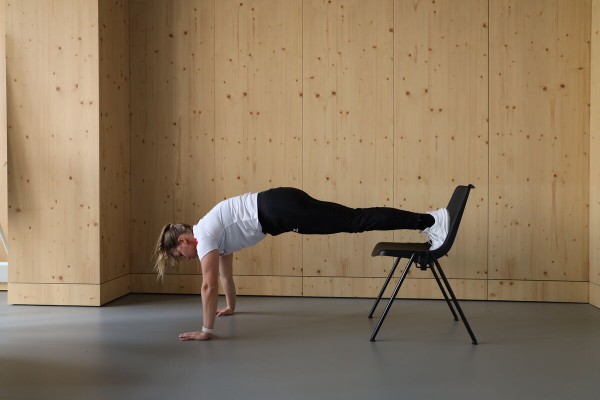
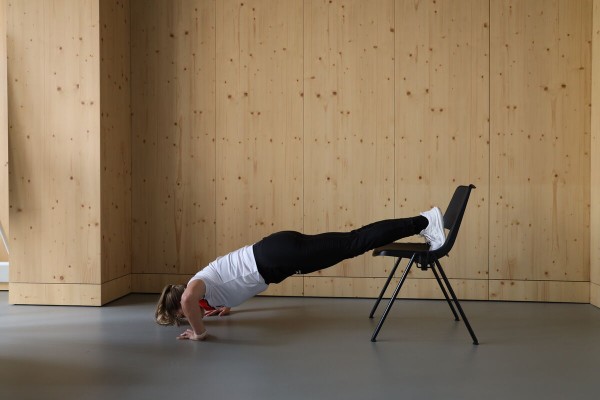
Push-up position with your feet on the seat of the chair, bend and stretch your arms (lower and raise your upper body).
Caution:
No hollow back, elbows bent approx. 45° from the upper body ("A" shape with the arms), shoulders fixed and pulled down towards the hips.
1 (office) chair
Push-up ► decline push up
Power
Individual work


Push-up position with your feet on a raised surface, bend and stretch your arms (lower and raise your upper body).
Attention:
No hollow back, elbows bent at an angle of approx. 45° from the upper body ("A" shape with the arms), shoulders fixed and pulled down towards the hips.
Lighten:
Support yourself in place (without bending and stretching your arms); lower your upper body less; place a lower support or legs on the floor.
Harden:
Additional weight (on the shoulders); unstable support for the arms.
Variation:
Vary the position of the hands/arms (e.g.: wide, narrow, together).
1 raised surface (e.g. indoor: long bench, vaulting box element; outdoor: tyre, wall)
1 weight vest/weight disc/sandbag ► to make the exercise more difficult (additional weight)
1 ball/balance cushion/balance board ► to make the exercise more difficult (unstable surface)
Push-up ► incline push up
Power
Individual work
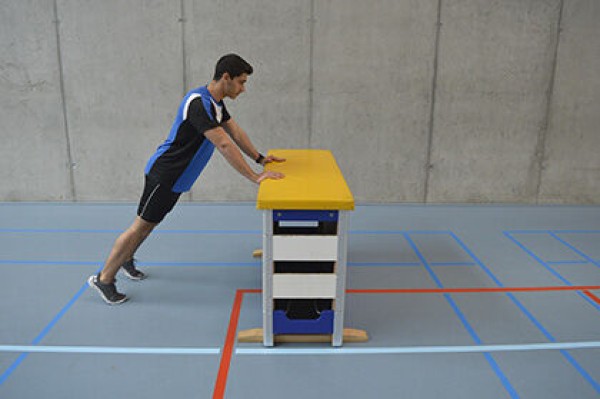
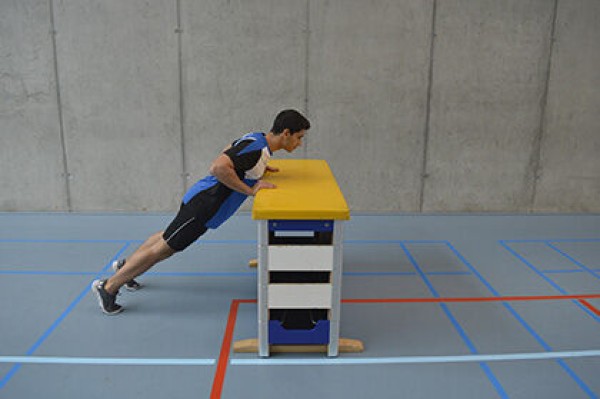
Push-up position, feet on the floor (tiptoe position), arms support the upper body on the edge of the top of the Swedish box, bend and stretch the arms (lower and raise the upper body).
Attention:
No hollow back, tense torso, elbows bent approx. 45° from the upper body ("A" shape with the arms), shoulders are fixed and pulled down towards the hips.
Lighten:
Support in place (without bending and stretching the arms); more box elements (more upright position).
Harden:
Less box elements (lower position); additional weight (on the back); swap the position of the arms/legs; unstable support for the legs.
3-4 vaulting box elements (incl. upper part)
1-2 additional box elements ► to make the exercise easier
1 weight waistcoat ► to make the exercise more difficult (additional weight)
1 weight disc/sandbag ► to make the exercise more difficult (additional weight) - if the position allows
1 ball/balance cushion/balance board ► to make the exercise more difficult (unstable base)
Push-up ► incline push up
Power
Individual work

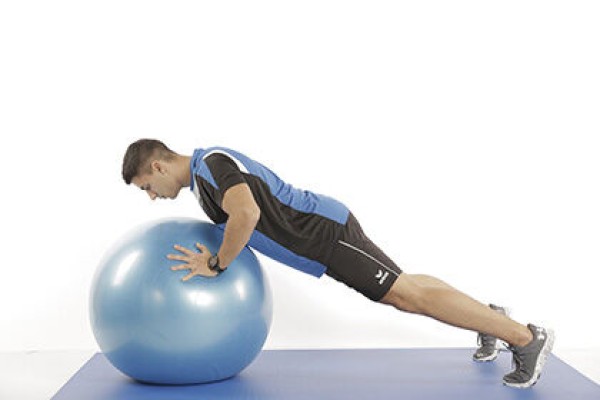
Push-up position, arms support the upper body on the exercise ball, bend and stretch arms (lower and raise upper body).
Attention:
No hollow back, elbows bent approx. 45° from the upper body ("A" shape with the arms), shoulders are fixed and pulled down towards the hips. To prevent the ball from rolling away, you can lean it against a wall.
Lighten:
Support yourself in place (without bending and stretching your arms); lower your upper body less.
Harden:
Lift one leg off the floor when lowering your upper body; additional weight (on your shoulders); unstable support for your legs.
1 exercise ball
1 weight vest/sandbag ► to make the exercise more difficult (additional weight)
1 ball/balance cushion/balance board ► to make the exercise more difficult (unstable base)
Push-up ► incline push up
Power
Individual work


Push-up position, feet on the floor (tiptoe position), arms support the upper body on the edge of the chair, bend and stretch the arms (lower and raise the upper body).
Attention:
No hollow back, tense torso, elbows bent approx. 45° from the upper body ("A" shape with the arms), shoulders are fixed and pulled down towards the hips.
1 (office) chair
Push-up ► incline push up
Power
Individual work

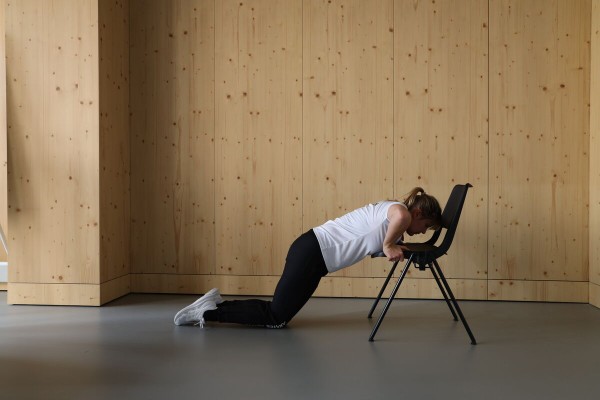
Kneeling position with upper body leaning forwards, arms supporting the upper body on the edge of the chair, bend and stretch arms (lower and raise upper body).
1 (office) chair
Push-up ► incline push up
Power
Individual work


Push-up position with your hands on a raised surface, bend and stretch your arms (lower and raise your upper body).
Attention:
No hollow back, elbows bent approx. 45° from the upper body ("A" shape with the arms), shoulders are fixed and pulled down towards the hips.
Lighten:
Support in place (without bending and stretching the arms); lower the upper body less; higher base.
Harden:
Additional weight (on the shoulders); hands placed on the floor; unstable support for the legs.
Variation:
Vary the position of the hands/arms (e.g.: wide, narrow, together).
1 raised surface (e.g. indoor: long bench, vaulting box element; outdoor: tyre, wall)
1 weight vest/weight disc/sandbag ► to make the exercise more difficult (additional weight)
1 ball/balance cushion/balance board ► to make the exercise more difficult (unstable surface)
Push-up ► narrow push up
Power
Individual work
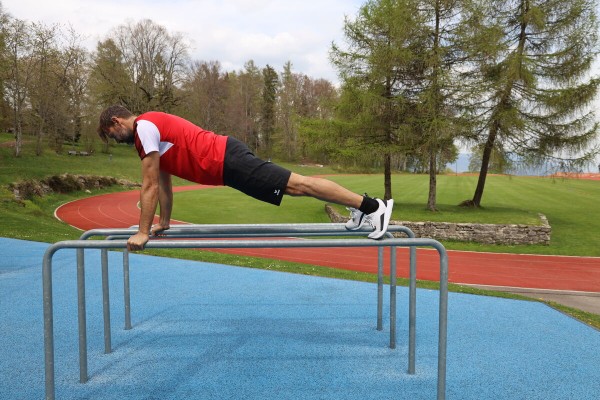

Push-up position with your feet on the bars and your hands gripping the bar, bend and stretch your arms (lower and raise your upper body). In the deep push-up position, the elbows are at the side of the body (no outward movement of the elbows).
Attention:
No hollow back, the shoulders are fixed and pulled down towards the hips.
Lighten:
Lower your upper body less (hardly bend your arms); normal push-ups on the floor (possibly even place your knees on the floor (feet held high). Standing upright, lean forwards and support your upper body with your hands on the bars with your arms outstretched, then bend and stretch your arms (bring your chest to the bar and back to the starting position).
Harden:
Additional weight (on your back).
1 weight vest/weight disc/sandbag/fighting backpack ► to make the exercise more difficult (additional weight)
Liegestütz ► narrow push up
Power
Individual work
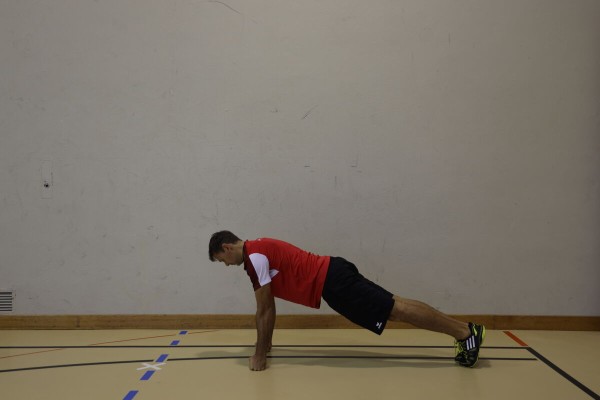
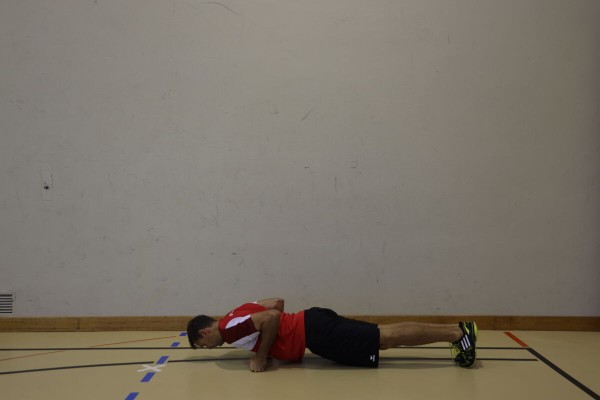
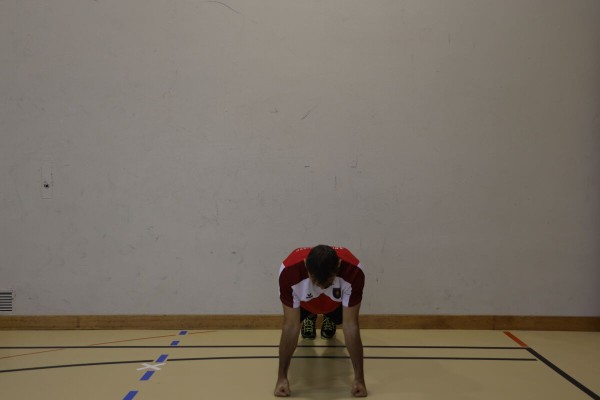

In the push-up position, bend and stretch your arms (lower and raise your upper body), resting your arms on the balls of your fists. In the deep push-up position, the elbows are at the side of the body (no outward movement of the elbows).
Attention:
Do not have a hollow back and bend the elbows at an angle of approx. 45° from the upper body ("A" shape with the arms). The shoulders are fixed and pulled down towards the hips.
Lighten:
Place your knees on the floor (feet held high); lower your upper body less (arms barely bent); support your arms on a raised surface.
Harden:
Additional weight (on your back); place your legs on a raised surface; unstable surface for your arms and/or legs.
1 weight vest/weight disc/sandbag/fighting backpack ► Make the exercise more difficult (additional weight)
1 ball/1-2 balance cushion/balance board ► Make the exercise more difficult (unstable base)
1 raised base ► Make the exercise easier or more difficult (position)
Push-up ► narrow push up / classic grip
Power
Individual work


Bend and stretch your arms in the push-up position (lower and raise your upper body). In the deep push-up position, the elbows are at the side of the body (no outward movement of the elbows).
Attention:
No hollow back and the elbows bent at an angle of approx. 45° from the upper body ("A" shape with the arms). The shoulders are fixed and pulled down towards the hips.
Lighten:
Place your knees on the floor (feet held high); lower your upper body less (arms barely bent); support your arms on a raised surface.
Harden:
Additional weight (on your back); place your legs on a raised surface; unstable surface for your arms and/or legs; try out push-up variations (e.g. clapping your hands).: clap your hands, one-arm, "crab", "spartan", "superman", "leg flag", "aztec" or "shaolin" push-ups).
Variant:
Vary the position of the hands/arms (e.g.: wide, narrow, together).
1 weight vest/weight disc/sandbag/fighting backpack ► Make the exercise more difficult (additional weight)
1 ball/1-2 balance cushion/balance board ► Make the exercise more difficult (unstable base)
1 raised base ► Make the exercise easier or more difficult (position)
Push-up ► push up
Power
Partner work


Both participants in a push-up position with their heads facing each other and approximately one arm's length apart. Bend and stretch your arms (lower and raise your upper body), whenever the upper body is raised, the participants reach a hand across the back. Switch sides/hands after each repetition.
Attention:
Actively tense your core (do not let your hips sag). The elbow position is not at shoulder height but slightly closer to the upper body ("A" shape with the arms). Shoulders are fixed and pressed down towards the hips.
Lighten:
Place your knees on the floor (feet held high); lower your upper body less (arms barely bent).
Harden:
Additional weight (on the back); raised base for the legs.
Per participant:
1 weight vest/weight disc/sandbag ► making the exercise more difficult (additional weight)
1 raised base ► making the exercise more difficult (position)
Push-up ► push up
Power
Partner work
1 trainee & 1 helper ► Note change of position
(= double the time required; for lesson planner see Organisation Kraft: Info button Execution)


Exerciser: Push-up position, place hands on (one small hand) on the top of the vaulting box, bend and stretch the arms (lower and raise the upper body).
Partner: Holds the feet of the active participant in a standing position at hip height.
Attention:
Actively tense the torso (do not let the hips sag), elbows are not at shoulder height but slightly closer to the upper body ("A" shape with the arms). Shoulders are fixed and pressed down towards the hips.
Lighten:
Place feet or knees on the floor (without partner); lower upper body less (arms barely bent).
Harden:
Additional weight (on the back); helper raises legs higher than hip height; lower upper body lower (below hand position - 2 swing box tops required).
Variant:
The helper also becomes the exerciser by performing a squat while the partner performs the push-ups (lower body: thigh/gluteal muscles).
1-2 vaulting box top(s)
1 weight disc/sandbag ► to make the exercise more difficult (additional weight)
Push-up ► push up
Power
Partner work
1 trainee & 1 helper ► Note change of position
(= double the time required; for lesson planner see Organisation Kraft: Info button Execution)


Trainee: From a standing position, lean with your hands on your partner's hands (strong support, good body tension), bend and stretch your arms to lower your upper body and raise it back to the starting position (push-up).
Partner: Lie on your back with your legs straight, arms stretched out and pointing upwards (holding out) to support/grip the hands of the active participant.
Attention:
Actively tense your torso (do not sag), elbows bent at approx. 45° from the upper body ("A" shape with the arms), shoulders are fixed and pressed down towards the hips.
Lighten:
Just hold the starting position; bend the arms less (barely lower the upper body).
Harden:
Hold the end position; additional weight (on the shoulders).
Variant:
The participant lying on their back becomes the exerciser by bending and stretching their arms to move their partner up and down (place their hands on their partner's chest if necessary).
1 weight vest/weight disc/sandbag ► Make the exercise more difficult (additional weight)
Push-up ► push up
Power
Partner work
If both load levels (top and bottom) are tried out ► Note the change of position
(= double the time required; for lesson planner see Organisation Strength: Info button Execution)


The participants stand on top of each other in a push-up position (preferably with partners of similar build), with the upper participant resting their feet on the back and their hands on the calves of the lower participant (heads pointing in opposite directions). Both participants bend and stretch their arms at the same time (upper body raised and lowered; push-up). Logically, the load on the lower participant is higher than that of their partner at the top (possibly change position).
Attention:
Actively tense the trunk (do not sag), elbow position is not at shoulder height but slightly closer to the upper body ("A" shape with the arms), shoulders are fixed and pushed down towards the hips.
Lighten:
Only hold the starting position; bend your arms less (barely lower your upper body).
Harden:
Additional weight for one or both participants (on the shoulders).
Variant:
The upper (lower) participant does not perform push-ups (only hold the position) so that the load is only increased for one exerciser.
1-2 weight waistcoat(s)/weight disc(s)/sandbag ► Make the exercise more difficult (additional weight)
Push-up ► push up
Power
Partner work
If both load levels (top and bottom) are tried out ► Note the change of position
(= double the time required; for lesson planner see Organisation Strength: Info button Execution)


One participant lies on their back with their arms stretched vertically upwards, the partner supports themselves with their hands on the shins of the participant lying on the floor, is also held by the shins and lifted into a horizontal position (both participants with stretched arms). Both exercisers bend and stretch their arms at the same time (lowering and raising the participant lying on top).
Attention:
The lifted partner actively tenses their torso so that their pelvis does not sag. The elbow position is not at shoulder height, but slightly closer to the upper body ("A" shape with the arms), shoulders are fixed and pressed down towards the hips.
Lighten:
Only hold the starting position.
Harden:
Additional weight for the upper participant (on the back).
Variant:
One exerciser bends and stretches the arms, while the partner keeps the arms stretched. The roles are swapped after each exercise or from time to time.
1 weight disc/weight vest/sandbag ► Make the exercise more difficult (additional weight)
Push-up ► push up
Power
Individual work


Push-up position with your arms supported on the tyre, bend and stretch your arms (lower and raise your upper body).
Attention:
Do not let your hips sag, actively tense your torso (no hollow back), elbows bent at an angle of approx. 45° from your upper body ("A" shape with your arms), keep your shoulders fixed and press down towards your hips.
Lighten:
Place your knees on the floor (feet held high); lower your upper body less (arms barely bent).
Harder:
Place your feet on a tyre or helmet; arms supported on a helmet (tight push-ups); additional weight (on your back); unstable support for your arms and/or legs.
Variation:
Vary the position of your hands (e.g.: wide, narrow, together).
1 tyre (DURO) ► make the exercise easier or more difficult (leg position)
1 helmet ► make the exercise more difficult (arm/leg position)
1 weight vest/weight disc/sandbag/fighting rucksack ► make the exercise more difficult (additional weight)
1 ball/1-2 balance cushions/balance board ► make the exercise more difficult (unstable surface)
Push-up ► push up
Power
Individual work
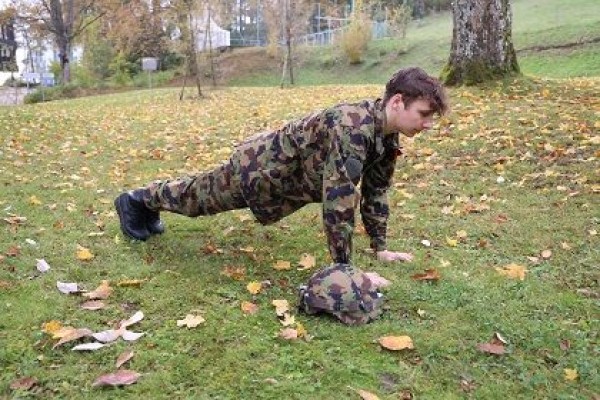
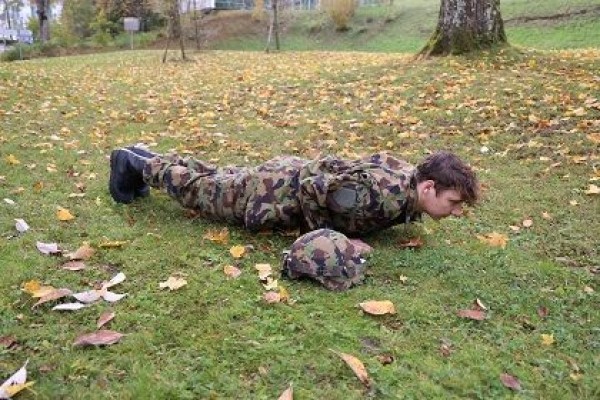
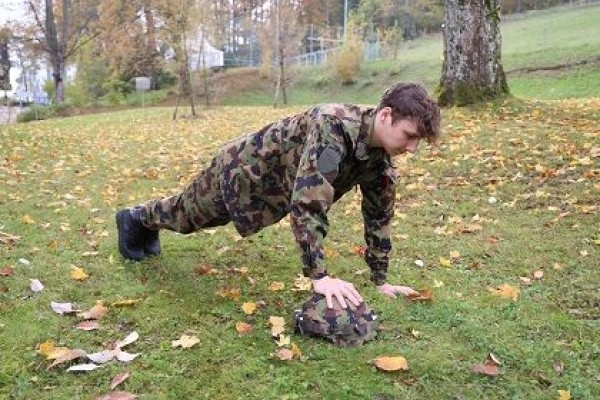
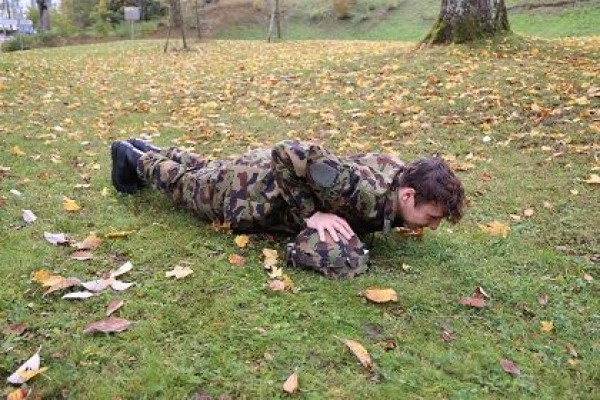
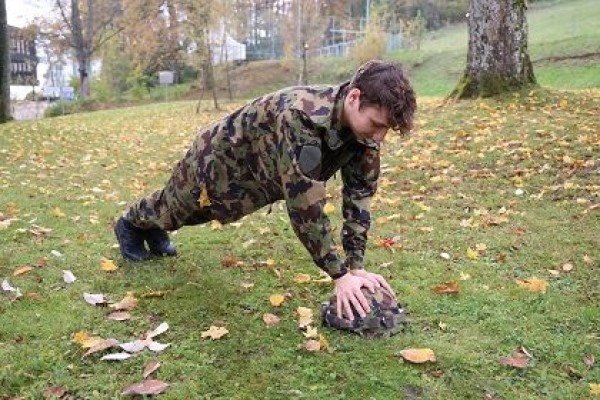
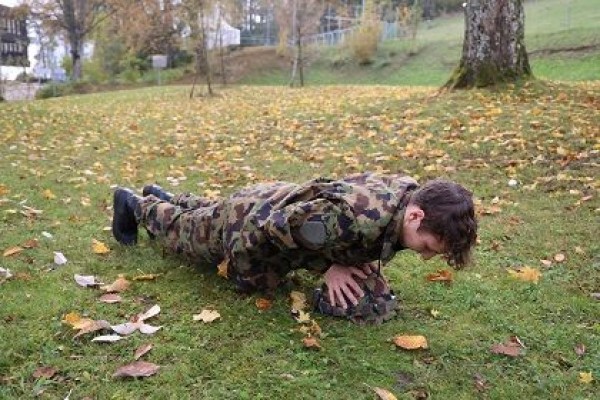
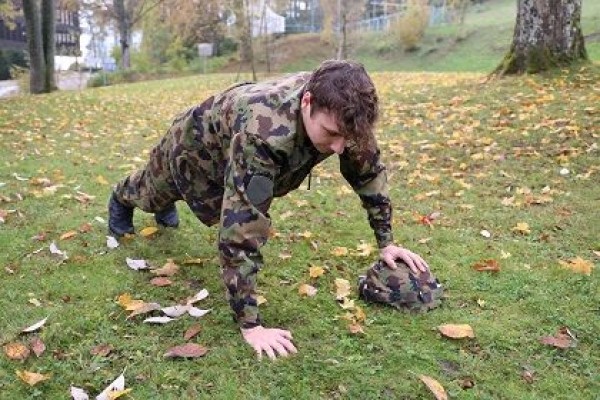

Place an object (e.g. helmet) on the floor. helmet) on the floor to perform the exercise in the following order:
Push-up position with your hands next to the object, perform push-ups,
support the hand facing the object on the object, the other hand remains on the floor, perform push-ups,
support both hands on the object, perform push-ups,
support one hand on the other side of the object on the floor, perform push-ups,
support both hands on the floor (opposite side of the starting position), perform push-ups,
continue the exercise in the opposite direction.
Attention:
Head, torso, hips and knees practically form a line (do not stretch your buttocks upwards or let them sag, tense your stomach). Elbows bent at an angle of approx. 45 degrees from the upper body ("A" shape with the arms). Shoulders are fixed and pressed down towards the hips.
Lighten:
Knees on the floor.
Heavy:
Additional weight (on the back); unstable base for the legs.
1 helmet/(medicine) ball
1 weight vest/weight disc/fighting backpack/sandbag/pneu (PUCH) ► Make the exercise more difficult (additional weight)
1 ball/1-2 balance cushions/1 balance board ► Make the exercise more difficult (unstable base)
Push-up ► push up
Power
Individual work


Push-up position on the balance board, one leg stretched out (in extension of the body) and one leg bent (kneeling) on the floor, arms bent and stretched (upper body lowered and raised).
Attention:
No hollow back, actively tense the torso. Elbows bent approx. 45 degrees from the upper body ("A" shape with the arms), shoulders are fixed and pressed down towards the hips.
Lighten:
Both legs bent on the floor (kneeling).
Harder:
Both legs stretched out in extension of the body (standing on the tips of the feet); additional weight on the back; unstable base for the legs too.
Variant:
Vary the position of the hands/arms (e.g. wide, narrow, together).
1 balance board incl. roller
1 weight vest/weight disc/sandbag ► to make the exercise more difficult (additional weight)
1 ball/balance cushion/(additional) balance board ► to make the exercise more difficult (unstable base)
Push-up ► push up
Power

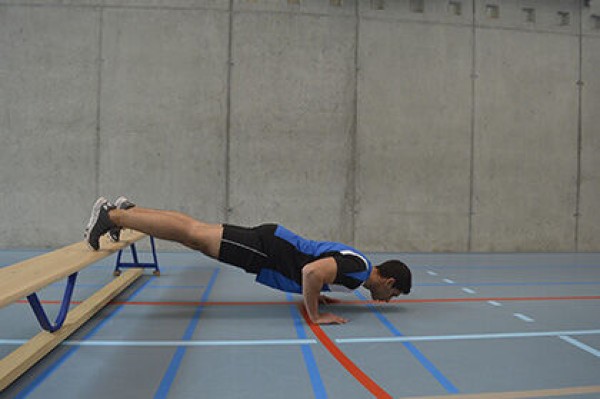
Push-up position, legs placed on the long bench; bend and stretch arms (lower and raise upper body).
Attention:
No hollow back, tense torso, elbows bent approx. 45° from upper body ("A" shape with arms), shoulders fixed and pulled down towards hips.
Lighten:
Support your arms on the long bench instead of your legs; lower your upper body less (hardly bend your arms); normal push-ups (arms and legs on the floor).
Harder:
Additional weight (on the back); unstable support for the arms.
Variant:
Vary the position of the hands/arms (e.g.: wide, narrow, together).
1 long bench
1 weight vest/weight disc/sandbag ► to make the exercise more difficult (additional weight)
1 ball/balance cushion/balance board ► to make the exercise more difficult (unstable surface)
Push-up ► push up
Power
Individual work


Push-up position, support your upper body with your hands on a ball/helmet (or place your hands on the ball), bend and stretch your arms (lower and raise your upper body).
Attention:
Do not arch your back, tense your torso, bend your elbows approx. 45° from the upper body ("A" shape with the arms), shoulders are fixed and pressed down towards the hips.
Lighten:
Just hold the starting position; lower the upper body less (barely bend the arms).
Harden:
Additional weight (on the shoulders); legs on an unstable surface.
1 ball (e.g. medicine or basketball)/helmet
1 weight vest/weight disc/sandbag ► to make the exercise more difficult (additional weight)
1 additional ball/balance cushion/balance board ► to make the exercise more difficult (unstable base)
Push-up ► push up
Power
Individual work


Push-up position on the balance board, both legs stretched out in extension of the body (standing on the toes), arms bent and stretched (upper body lowered and raised).
Attention:
No hollow back, actively tense the torso. Elbows bent approx. 45 degrees from the upper body ("A" shape with the arms), shoulders are fixed and pressed down towards the hips.
Lighten:
Both legs bent on the floor (kneeling); one leg bent (kneeling) on the floor.
Harder:
Additional weight on the back; unstable base for the legs too.
Variant:
Vary the position of the hands/arms (e.g. wide, narrow, together).
1 balance board incl. roller
1 weight vest/weight disc/sandbag ► to make the exercise more difficult (additional weight)
1 ball/balance cushion/(additional) balance board ► to make the exercise more difficult (unstable base)
Push-up ► push up
Power
Individual work


Push-up position, support your upper body with your hands on a balance cushion, bend and stretch your arms (lower and raise your upper body).
Attention:
Do not hollow back, tense your torso, bend your elbows at an angle of approx. 45° from your upper body ("A" shape with your arms), fix your shoulders and press them down towards your hips.
Lighten:
Just hold the starting position; lower your upper body less (barely bend your arms).
Harden:
Additional weight (on the shoulders); legs on an unstable surface.
Variation:
Replace the balance cushion with a balance hemisphere.
2 balance cushions
1 weight vest/weight disc/sandbag ► Make the exercise more difficult (additional weight)
1 ball/additional balance cushion/balance hemisphere/balance board ► Make the exercise more difficult (unstable surface)
1 balance hemisphere ► Variation of the exercise
Push-up ► push up
Power
Individual work




Push-up position, one hand on the floor and the other hand supported on a medicine ball/helmet, both hands positioned at about shoulder height, the body practically forming a straight line (the head is held in extension of the spine), bend the arms at the elbow joint, lower the upper body to the ball (lower and raise the upper body) and return to the starting position by stretching the arms. After a few repetitions (or after each exercise), switch sides.
Attention:
Do not arch your back, tense your core.
Lighten:
Just hold the starting position; lower your upper body less (barely bend your arms).
Harder:
Additional weight (on the shoulders); legs on an unstable surface.
Variation:
Push-ups with hand change: roll the ball from one side to the other after each push-up.
1 ball (e.g. medicine or basketball)/helmet
1 weight vest/weight disc/sandbag ► to make the exercise more difficult (additional weight)
1 additional ball/balance cushion/balance board ► to make the exercise more difficult (unstable base)
Push-up ► push up
Power
Individual work


Push-up position with your feet on the balance board (board pointing to the side, T-position), bend and stretch your arms (lower and raise your upper body).
Attention:
Do not arch your back and bend your elbows at an angle of approx. 45° from your upper body ("A" shape with your arms). Keep your shoulders fixed and pull them down towards your hips.
Lighten:
Just hold the push-up position; lower your upper body less (barely bend your arms).
Harder:
Additional weight (on the back); also unstable support for the arms.
Variant:
Vary the position of the hands/arms (e.g.: wide, narrow, together).
1 balance board
1 weight vest/weight disc/sandbag ► to make the exercise more difficult (additional weight)
1 ball/balance cushion/balance board ► to make the exercise more difficult (unstable base)
Push-up ► push up
Power
Individual work

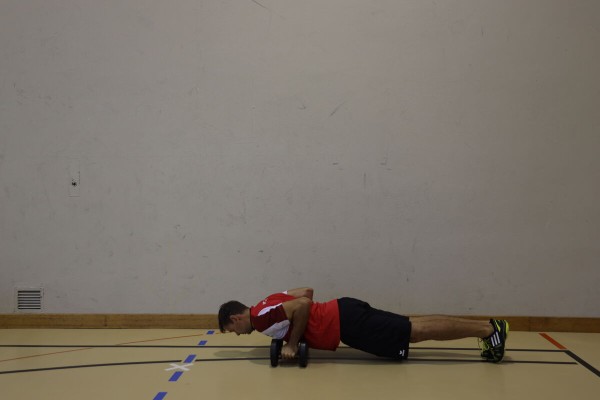
Both hands are supported in a push-up position on a dumbbell each (kettlebell also possible) (backs of hands pointing to the respective side), bend and stretch the arms (lower and raise the upper body).
Attention:
Keep the torso stable and don't let it sag (actively tense the torso muscles).
Lighten:
Place your hands on the floor.
Harden:
More weight; additional weight (on the back).
Variation:
Vary the position of the hands/arms (e.g.: wide, narrow, together).
2 dumbbells/kettlebells
1 weight vest/weight disc/sandbag/fighting backpack ► Make the exercise more difficult (additional weight)